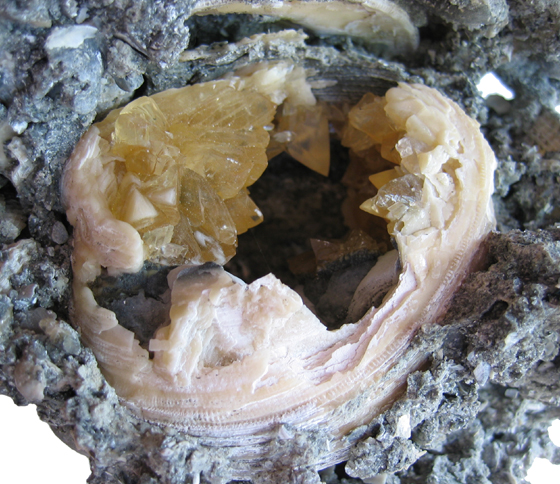
 |
 |
 Fossil Clam Mercenaria permagna Pliocene/Pleistocene Ruck's Pit, Okeechobee County, Florida |
|
Silica that fills in empty spaces or replaces structure in organic materials during permineralization undergoes a recrystallization process. In this case, it is not the original organic matter that is recrystallized. Permineralized fossils form when solutions rich in minerals permeate porous tissue, such as bone or wood. Minerals precipitate out of solution and fill the pores and empty spaces. During the initial stages of permineralization amorphous silica infills pits connecting cells and cell lumina (the cavity enclosed by the cell walls). At this early stage no replacement has occurred. Replacement of cellulose in the walls of cells may occur as permineralization continues. Cellulose that degrades leaves room for the emplacement of silica between and within cells walls. The more decay resistant lignin that remains in the cell walls continues to act as a guiding framework to preserve structure. Silica that initially permeates the porous tissue is amorphous. Silica that replaces cell wall material is also amorphous. This amorphous silica is unstable and slowly crystallizes to more stable forms over millions of years. The transition to more stable forms of silica involves continued polymerization and water loss. Higher ordered forms of opal are created through this process and eventually lead to the thermodynamically more stable silica quartz (Stein, 1982, p. 1277). The quality of preservation usually, but not always, declines during successive stages of silicification (Mustoe, 2003, p. 36). Read our article on Permineralization in the Fossil Types section of our museum to learn more.
Mustoe, G.E. (2003). Microscopy of Silicified Wood. Microscopy Today, vol 11, no 6, pp. 34-37. Prothero, D.R. (2004). Bringing Fossils to Life: An Introduction to Paleobiology [2nd edition]. New York: McGraw-Hill. Stein,
C.L. (1982). Silica Recrystallization in Petrified Wood. Journal
of Sedimentary Petrology, vol 52, no 4. pp. 1277-1282. |










